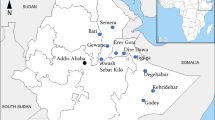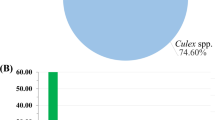Summary
On July 15, 2012, adult Anopheles hyrcanus (Pallas 1771) mosquitoes were caught next to a farm barn near Rust, Burgenland, close to Lake Neusiedl National Park in eastern Austria. Six weeks later, adults of this invasive species were also found in a sheep shelter outside the village of Oggau and another 2 weeks later, in a horse barn in Mörbisch. The morphological typing was confirmed genetically by amplification and sequencing of a 1,404-bp-long fragment within the 5.8S ribosomal RNA gene, the internal transcribed spacer 2, and the 28S ribosomal RNA gene. Out of two A. hyrcanus pools analyzed, one was found positive for Plasmodium sp. A 460-bp-long sequence within the mitochondrial cytochrome b region revealed 100 % identity to a sequence of a Plasmodium parasite identified in a New Zealand bellbird (Anthornis melanura). The Austrian finding sites are close to the Hungarian border. In Hungary, the occurrence of A. hyrcanus was already reported in 1963. A. hyrcanus is considered the most important potential vector of malaria in southern France today. In Austria, sporadic autochthonous malaria cases could emerge, caused by immigration from malaria-endemic countries and heavy tourism. However, the broad population coverage of the Austrian health care system makes the reestablishment of endemic areas for malaria unlikely.
Zusammenfassung
Am 15. Juli 2012 wurden adulte Stechmücken der Spezies Anopheles hyrcanus (Pallas 1771) bei Rust im Burgenland erstmalig in Österreich nachgewiesen. Am 28. August 2012 gelang ein Nachweis dieser invasiven Art auch in einem Schafstall bei Oggau am Neusiedler See und zwei Wochen danach in einem Pferdestall in Mörbisch. Die morphologische Bestimmung wurde mittels Sequenzierung eines 1.404 bp langen Fragmentes der genomischen DNS bestätigt. In einer von zwei gepoolten Proben konnte molekularbiologisch zudem Plasmodium sp. nachgewiesen werden: eine 460 bp lange Sequenz aus der mitochondrialen Cytochrom B Region zeigte 100 % Homologie mit der publizierten Sequenz einer aviären Plasmodie. Die beschriebenen Fundorte im Burgenland unterstreichen die Bedeutung anthropogener Bruthabitate für diese invasive Stechmücken-Art. A. hyrcanus ist in Ungarn schon seit 1963 bekannt und gilt in Südfrankreich als wichtigster Überträger autochthoner Malaria. Bei starkem Immigranten- oder Touristenaufkommen scheint ein lokales, spontanes Auftreten von Malaria auch in Österreich möglich. Die Etablierung endemischer Malariaherde ist aufgrund der breiten Abdeckung durch das österreichische Gesundheitssystem nicht zu erwarten.

Similar content being viewed by others
References
Bakonyi T, Ivanics E, Erdélyi K, Ursu K, Ferenczi E, Weissenböck H, Nowotny N. Lineage 1 and 2 strains of encephalitic West Nile virus, central Europe. Emerg Infect Dis. 2006;12:618–23.
Mehlhorn H, Walldorf V, Klimpel S, Jahn B, Jaeger F, Eschweiler J, et al. First occurrence of Culicoides obsoletus-transmitted Bluetongue virus epidemic in central Europe. Parasitol Res. 2007;101:219–28.
Hoffmann B, Scheuch M, Höper D, Jungblut R, Holsteg M, Schirrmeier H, et al. Novel orthobunyavirus in cattle, Europe, 2011. Emerg Infect Dis. 2012;18:469–72.
European Centre for Disease Prevention and Control. Guidelines for the surveillance of invasive mosquitoes in Europe (2012) ECDC, Stockholm; 2012. http://www.ecdc.europa.eu/en/publications/Publications/TER-Mosquito-surveillance-guidelines.pdf. Accessed 31 Dec 2012. ISBN 978-92-9193-378-5, doi:10.2900/61134.
European Centre for Disease Prevention and Control. Climate change and communicable diseases in the EU Member States (2012) ECDC technical document, Stockholm; 2010. http://www.ecdc.europa.eu/en/publications/Publications/1003_TED_handbook_climatechange.pdf. Accessed 31 Dec 2012. ISBN 978-92-9193-206-1, doi:10.2900/27967.
Fischer D, Thomas S, Beierkuhnlein C. Climate change effects on vector-borne diseases in Europe. Nova Acta Leopoldina. 2010;112:99–107.
Seidel B, Duh D, Nowotny N, Allerberger F. Erstnachweis der Stechmücken Aedes (Ochlerotatus) japonicus japonicus (Theobald, 1901) in Österreich und Slowenien in 2011 und für Aedes (Stegomyia) albopictus (Skuse, 1895) in Österreich 2012 (Diptera: Culicidae). Entomologische Zeitschrift. 2012;122:223–6.
Aberle S, Heinz FX. West Nil Virus Infektionen in Österreich. Virusepidemiologische Inf. 2012;12(12):1–2.
Seidel B. Freilanduntersuchungen an heimischen Stechmücken (Culicidae, Gelsen). CarinthiaII. 2000;190/110;547–54.
Mihályi F, Gulyás M. Magyarorszagh csipöszunyogjai. Budapest: Akademia Kiado; 1963. p. 229.
Tóth S, Kenyeres Z. Revised checklist and distribution maps of mosquitoes (Diptera, Culicidae) of Hungary. European Mosq Bull. 2012;30:30–65.
Aspöck H, Kunz C, Pretzmann G. Phänologie und Abundanz der Stechmücken des östlichen Neusiedlersee-Gebietes (Ost-Österreich) in ihrer Beziehung zum Auftreten der durch Stechmücken übertragenen Arboviren. Zbl Bakt I Abt Orig. 1970;214:160–73.
Seidel B, Gruber E. Stechmückenuntersuchung in der March- und Thayaregion 1997. St. Pölten: Amt der NÖ Landesregierung; 1998.
Moog O. Fauna Aquatica Austriaca, Lieferung Mai/95. Wien: Bundesministerium für Land- und Forstwirtschaft, Wasserwirtschaftskataster; 1995.
Hellgren O, Waldenström J, Bensch S. A new PCR assay for simultaneous studies of Leucocytozoon, Plasmodium, and Haemoproteus from avian blood. J Parasitol. 2004;90:797–802.
Cameron EC, Wilkerson RC, Mogi M, Miyagi I, Toma T, Kim HC, Fonseca DM. Molecular phylogenetics of Aedes japonicus, a disease vector that recently invaded Western Europe, North America, and the Hawaiian islands. J Med Entomol. 2010;47:527–35.
Becker N, Petric D, Zgomba M, Boase C, Madon M, Dahl C, Kaiser A. Mosquitoes and their control. 2nd ed. Heidelberg: Springer; 2010.
Tóth S. Quantitative and qualitative investigations into the Culicidae-fauna of the Tisza-Basin. Tiscia. 1977;7:93–9.
Tóth S. Culicidae, Therevidae and Tachinidae (Diptera) in the Aggtelek National Park. In: Mahunka S, editor. The fauna of the Aggteleki National Park. Budapest: MTM; 1999. pp. 517–24.
Tóth S. Sopron környékének csípőszúnyog faunája (Diptera: Culicidae). http://www.sopronihegyseg.hu/html/web_szunyog.html. Accessed 31 Dec 2012.
Halgos J, Benková I. First record of Anopheles hyrcanus (Diptera: Culicidae) from Slovakia. Biologia Bratisl. 2004;59 Suppl 15:68.
Sebesta O, Rettich F, Minár J, Halouzka J, Hubálek Z, Juricová Z, et al. Presence of the mosquito Anopheles hyrcanus in South Moravia, Czech Republic. Med Vet Entomol. 2009;23:284–6.
Seidel B. Diversity, dynamics and vector activity of the mosquito fauna (Diptera, Culicidae) in the Austrian March- and Thaya region. Wiss Mitt Niederösterr Landesmus St. Pölten. 2011;22:415–30.
Wernsdorfer WH. Malaria in Mitteleuropa. Denisia 6, zugleich Kataloge des OÖ. Landesmus N F. 2002;184:201–12.
Bruce-Chwatt JL, de Zulueta J. The rise and fall of malaria in Europe. Oxford: Oxford University Press; 1980.
Jettmar MH. Malaria in Austria. 4th International Congress of Tropical Medicine and Malaria, (1)640–5. Washington DC: Proceedings; 1948.
Postiglione M, Tabanli B, Ramsdale CD. The Anopheles of Turkey. Riv Parasitol. 1973;34:127–59.
Danis K, Baka A, Lenglet A, Van Bortel W, Terzaki I, Tseroni M, et al. Autochthonous Plasmodium vivax malaria in Greece, 2011. Euro Surveill. 2011;16(42):pii = 19993. http://www.eurosurveillance.org/ViewArticle.aspx?ArticleId=19993. Accessed 31 Dec 2012.
Ponçon N, Balenghien T, Toty C, Ferré JB, Thomas C, Dervieux A, et al. Effects of local anthropogenic changes on potential malaria vector Anopheles hyrcanus and West Nile virus vector Culex modestus, Camargue, France. Emerg Infect Dis. 2007;13:1810–5.
Krüger A, Rech A, Su XZ, Tannich E. Two cases of autochthonous Plasmodium falciparum malaria in Germany, with evidence for local transmission by indigenous Anopheles plumbeus. Trop Med Int Health. 2001;6:983–5.
Acknowledgments
This study was partially funded by the Austrian Research Association (ÖFG) MOEL project no. 465/2010–11 and the EU grants HEALTH.2010.2.3.3-3 project no. 261391 EuroWestNile (http://eurowestnile.isciii.es/ewn), FP7-261504 EDENext, and FP7-262042 ERINHA. Thanks to Francis Schaffner for morphological confirmation of the species determination, to Sabine Maritschnik for drafting the map, and to Georg Krupitza and Valentin Olle for field work.
Conflict of interest
The authors declare that there is no conflict of interest.
Author information
Authors and Affiliations
Corresponding author
Rights and permissions
About this article
Cite this article
Seidel, B., Silbermayr, K., Kolodziejek, J. et al. Detection of Plasmodium sp.-infested Anopheles hyrcanus (Pallas 1771) (Diptera: Culicidae) in Austria, 2012. Wien Klin Wochenschr 125, 139–143 (2013). https://doi.org/10.1007/s00508-013-0331-5
Received:
Accepted:
Published:
Issue Date:
DOI: https://doi.org/10.1007/s00508-013-0331-5




